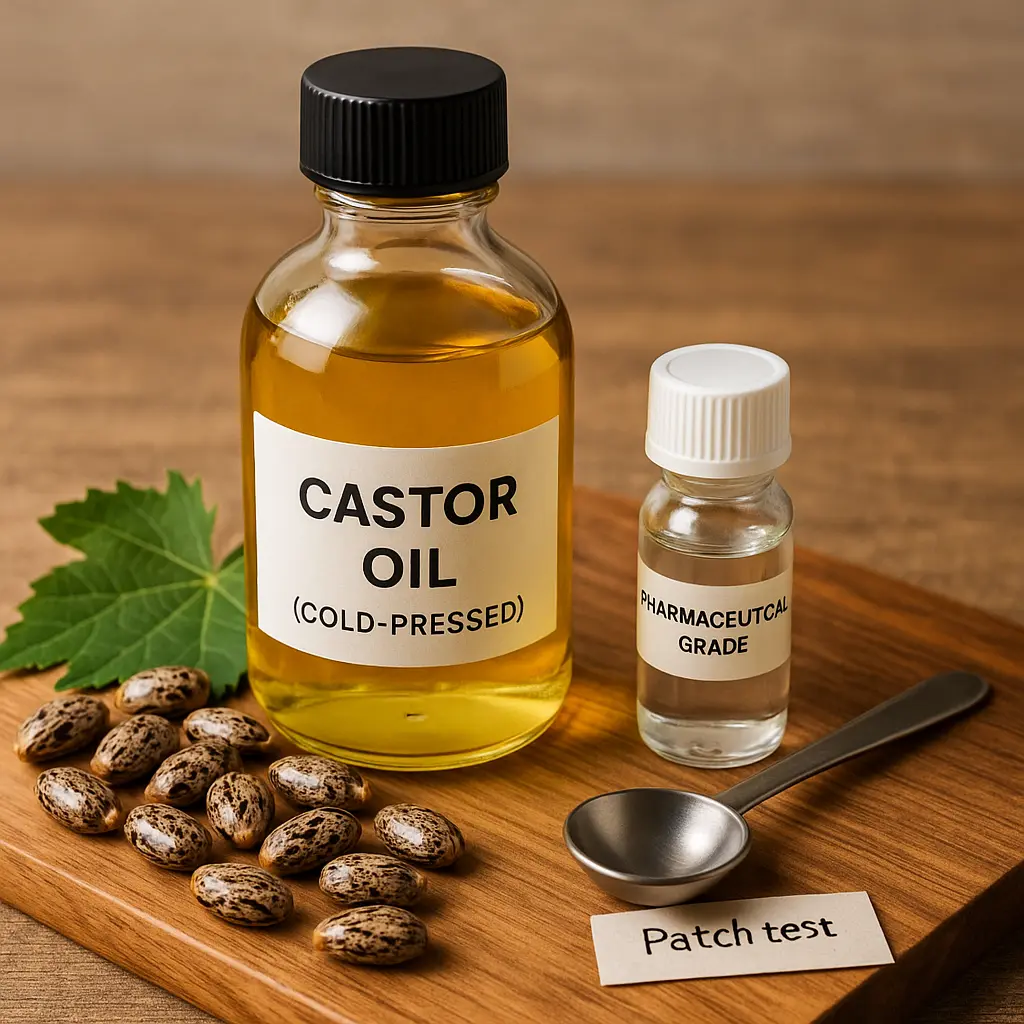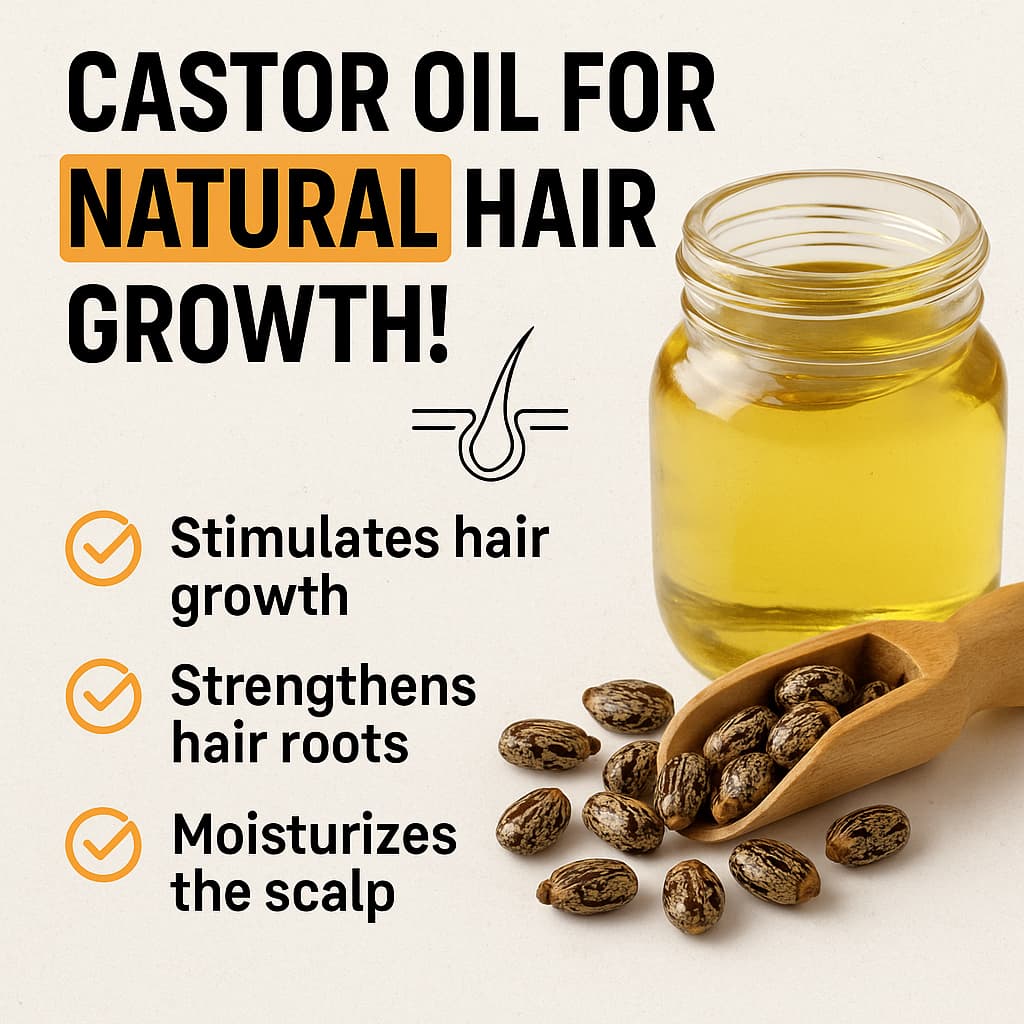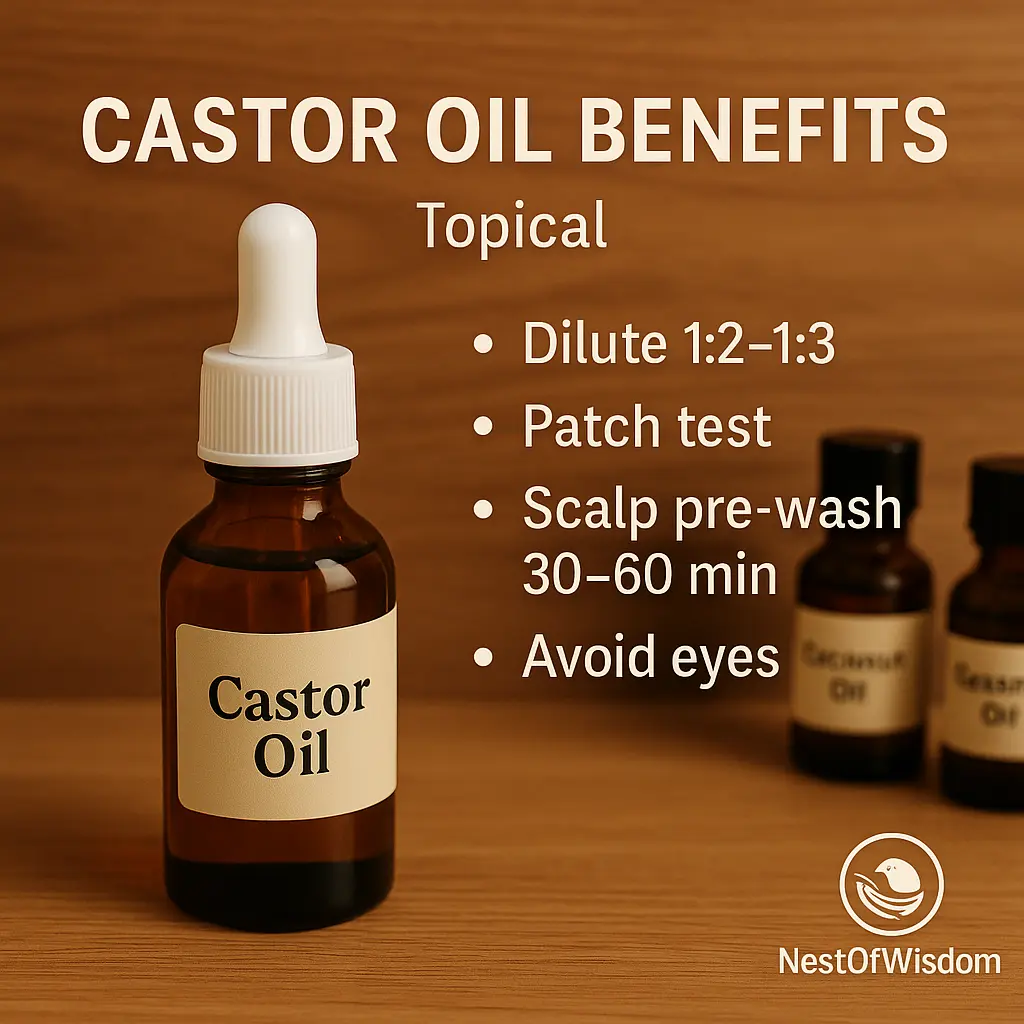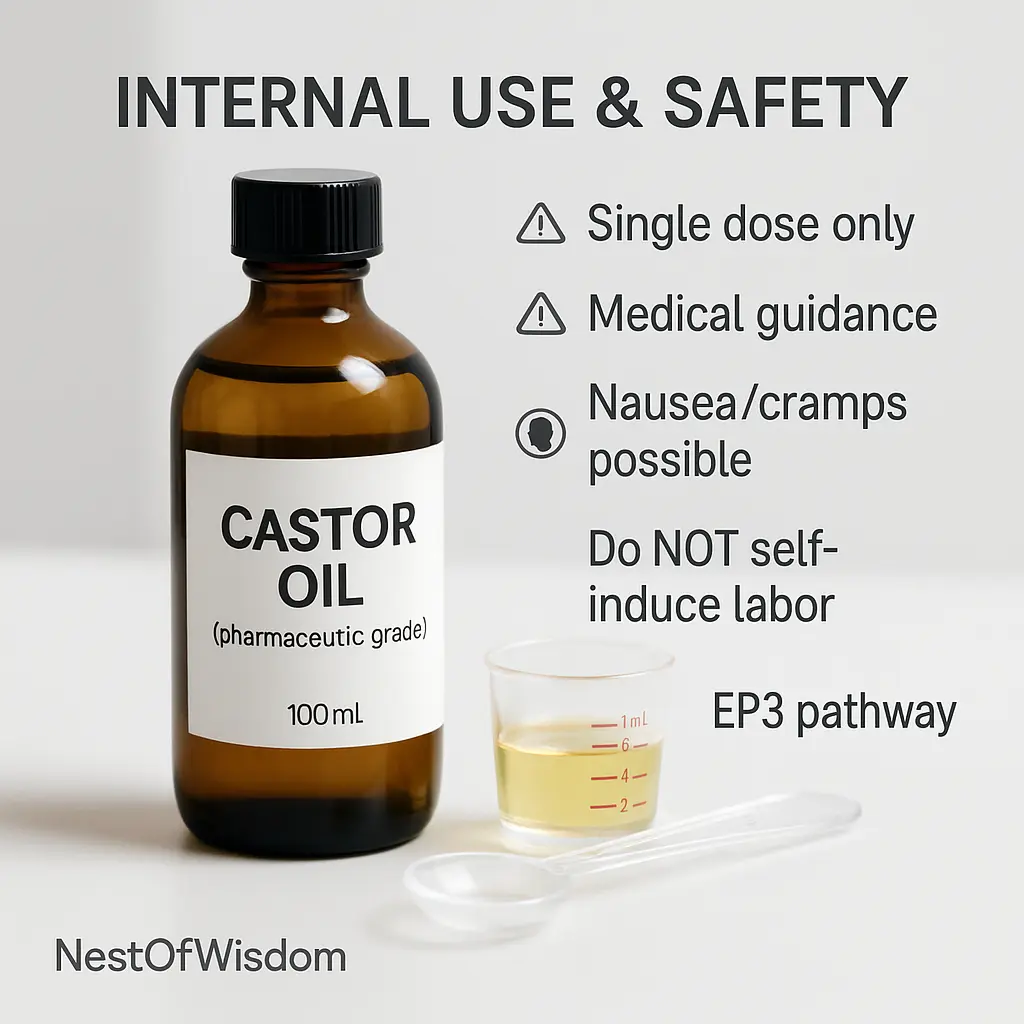Table of Contents
- Introduction
- What Is Castor Oil? (Why it powers Castor Oil Benefits)
- Composition & How It Works (EP3 pathway)
- Castor Oil Benefits: Evidence-Backed Uses
- Hair & Skin: What’s Real vs Hype
- How to Use Castor Oil Safely (Internal & External)
- How to Choose Quality Oil & Store It Right
- Where It Fits Among Traditional Oils
- Quick Routines You Can Actually Follow
- Castor Oil Packs: Evidence & Safety
- Interactions & When to Avoid
- Patch Test & Sensitivity Guide
- Troubleshooting & Common Mistakes
- Topical Blend Recipes (Non-Medicinal)
- Mini Case Studies
- FAQs: Castor Oil Benefits
- Conclusion
- References
Introduction
Castor Oil Benefits have lived in home routines for generations—comforting dry skin, helping with occasional constipation, and supporting scalp care. Today, research explains much of the “how,” especially the role of ricinoleic acid. This guide blends ancestral wisdom with science so you can use castor oil safely and confidently in everyday life.
In plain language, Castor Oil Benefits cover short-term laxative support, simple hair/skin routines, and calm, safety-first habits you can repeat.
தமிழ் குறிப்பை: “அளவும் மருந்து; முறையும் மருந்து.” — சரியான அளவில், சரியான முறையில் பயன்படுத்தினால் பலன்.
Below we translate Castor Oil Benefits into practical steps—clear when to use (and when to avoid), how to choose the right grade, and simple routines you can repeat.
What Is Castor Oil? (Why it powers Castor Oil Benefits)
Castor oil is expressed from the seeds of Ricinus communis. Properly processed, reputable products are free of ricin (the toxic protein in raw beans). What remains is a triglyceride-rich oil dominated by ricinoleic acid—central to many Castor Oil Benefits.
- Cold-pressed: Favored for topical routines (scalp, brows, heels/elbows) and traditional external use.
- Pharmaceutical-grade: Purified, clearly labeled for medicinal use. Under clinical guidance, it can act as a short-term stimulant laxative.
Choosing the right grade is how you unlock everyday Castor Oil Benefits without unwanted effects.


Composition & How It Works (EP3 pathway)
The signature fatty acid is ricinoleic acid (~85–90%). A pivotal mechanistic study showed ricinoleic acid activates the prostaglandin EP3 receptor, explaining the laxative action on intestinal smooth muscle and uterine effects. This mechanism underpins several Castor Oil Benefits—and important safety cautions discussed below.
This EP3 pathway neatly connects the science to practical Castor Oil Benefits in both medicinal and topical contexts.
Castor Oil Benefits: Evidence-Backed Uses
1) Short-Term Constipation Relief (Stimulant Laxative)
Via the ricinoleic-acid/EP3 pathway, castor oil can help induce a bowel movement. In practice, clinicians reserve it for short-term relief or specific pre-procedure contexts because nausea and cramping are common. It’s not a daily wellness supplement.
2) Cervical Ripening/Labor Induction — Strictly Medical
Traditional midwifery has used castor oil near term. Evidence is mixed: some analyses suggest possible efficacy in select settings, while side effects (notably nausea) are frequent. This remains a medical decision under obstetric supervision—never DIY.
3) Occlusive Moisturizer & Barrier Support
As a thick, occlusive oil, castor oil can reduce transepidermal water loss and help dry areas (heels, elbows, lips). Dermatology reviews note conditioning benefits for hair shafts and scalp comfort, while strong evidence for new hair growth is limited—so treat it as supportive care, not a miracle cure.
4) Formulation Component in Wound-Care Research
Derivatives of ricinoleic acid appear in research-grade dressings/ointments designed to modulate inflammation and support moist wound environments. This does not mean applying kitchen oil to open wounds; follow clinical guidance.
Hair & Skin: What’s Real vs Hype


Helps with: lubrication/conditioning (less breakage), scalp comfort as a pre-wash, moisture retention on rough patches.
Hype to ignore: dramatic regrowth claims. Robust clinical evidence for new hair growth is limited; Castor Oil Benefits here are mainly conditioning and barrier support.
Rare caution: heavy, undiluted application can—rarely—cause acute hair felting (sudden matting). Dilute, use small amounts, and detangle gently.
தமிழில்: “அதிகம் போட்டால் பாதகம்.” — அளவோடு, கலந்தே பயன்படுத்துங்கள்.
Used this way, you’ll see the tangible Castor Oil Benefits of smoother detangling, better slip, and calmer scalp comfort.
How to Use Castor Oil Safely (Internal & External)
Topical routines (common)
- Scalp pre-wash: Mix 1 part castor oil with 2–3 parts lighter oil (coconut or sesame). Massage 5–8 minutes. Leave 30–60 minutes. Shampoo well (two cleanses if needed).
- Brows/edges: A drop with a clean spoolie, 3–4×/week; avoid eyes.
- Dry spots: Thin layer on heels/elbows at night; cotton socks/gloves help occlusion.


Internal use (stimulant laxative)
For short-term constipation only and only with the right product (pharmaceutical-grade) under medical guidance. Expect possible nausea/cramps; avoid chronic reliance. Pregnant individuals should not self-administer for induction.


Small, consistent steps protect you while delivering reliable Castor Oil Benefits over time.
How to Choose Quality Oil & Store It Right
- Purpose-fit the grade: Pharmaceutical-grade for internal use; cold-pressed, hexane-free for routine topical care.
- Packaging: Opaque/glass bottles with batch/lot numbers and clear labeling.
- Freshness: Buy smaller bottles if you use it slowly; store cool, dark, and dry; discard rancid/off-odor oil.
- Patch testing: Essential for sensitive or acne-prone skin; see guide below.
Good sourcing, clear labels, and fresh stock preserve the everyday Castor Oil Benefits people actually feel.
Where It Fits Among Traditional Oils
Compared with other staples, Castor Oil Benefits are unique and mostly non-culinary:
- Vs Coconut Oil: Coconut suits light cooking/scalp care with a pleasant aroma; castor is thicker, more occlusive, not for frying.
- Vs Sesame Oil: Sesame works for medium-heat cooking and abhyanga; castor is targeted topical or supervised medicinal use.
- Vs Ghee: Ghee shines in high-heat cooking/digestive comfort; castor is a short-term laxative and occlusive moisturizer.
- Vs Groundnut Oil: Groundnut is a neutral, vitamin-E-rich kitchen oil; castor oil is not a daily cooking fat.
- For rotation insights, see Coconut Oil vs Sesame Oil vs Ghee.
Quick Routines You Can Actually Follow
“Sunday Reset” (Topical)
- Warm 1 tsp castor oil; blend 1:2 with coconut/sesame.
- Massage scalp 5–8 min; leave 30–45 min; shampoo well.
- Dab a thin layer on heels/elbows; cotton socks/gloves overnight.
“Travel Relief” (Medical Guidance Only)
If a clinician suggests it, keep a clearly labeled pharmaceutical-grade bottle for occasional constipation during travel. Use single doses only; hydrate; never use to self-induce labor.
Castor Oil Packs: Evidence & Safety
Castor Oil Benefits are often discussed with “packs”—a cloth lightly soaked in oil, covered with a towel and gentle warmth. Evidence is limited/mixed, but many report comfort and relaxation.
- Do: Light soak, warm—not hot—compress for 20–30 minutes; clean skin after.
- Don’t: Apply to broken skin, use high heat, or use during pregnancy unless your clinician okays it.
If you enjoy the ritual, keep it gentle and brief so the perceived Castor Oil Benefits stay net-positive.
தமிழ் குறிப்பை: “நிதானமே நலம்.” — மெதுவாக, பாதுகாப்பாக செய்யுங்கள்.
Interactions & When to Avoid
- Pregnancy: Because of EP3-mediated uterine effects, do not self-use internally for labor—this is an obstetric decision.
- Chronic constipation: Castor oil is not a long-term solution; chronic stimulant laxatives may worsen bowel habits/electrolytes.
- GI red flags: Severe pain, blood in stool, suspected obstruction—seek medical help, don’t self-treat.
- Medications/kidney issues: Discuss any laxative use with your doctor first.
- Children: Avoid internal use unless a pediatrician directs it. Topical: minimal amounts, avoid eyes/mouth.
Respecting these lines keeps Castor Oil Benefits on your side—and risks out of the picture.
Patch Test & Sensitivity Guide
- Clean a small inner-forearm area; apply diluted oil (1:2 with coconut/sesame).
- Leave 24 hours. Redness/itch/bumps = discontinue.
- For face/brows, repeat on the jawline before regular use.
Tip: Acne-prone or seborrheic skin? Start lighter (1:3), shorter contact times.
Troubleshooting & Common Mistakes
- “Hair feels sticky/matted”: Use less, dilute to 1:3, shorten contact time, comb from ends upward. Rarely, heavy use has led to acute hair felting—stay light.
- “Eye irritation”: Keep away from eyelid margins; a speck on brows is enough. If it gets in eyes, rinse thoroughly.
- “Smells off”: Oil may be old—buy smaller bottles, store cool/dark, seal tightly.
- “Constipation keeps returning”: Focus on hydration, fiber, movement, and clinician-guided strategies; reserve medicinal use for specific situations.
- “Which bottle?”: Pharmaceutical-grade = supervised internal use; cold-pressed, hexane-free = routine topical care.
Topical Blend Recipes (Non-Medicinal)
These simple blends help you realize everyday Castor Oil Benefits without heaviness; adjust ratios for your hair/skin.
1) Scalp Pre-Wash (Weekly)
- Castor oil 1 tsp + coconut oil 2 tsp (1:2). Optional: 1–2 drops rosemary (cosmetic; patch test).
- Massage 5–8 min; leave 30–45 min; shampoo well. Frequency: 1–2×/week.
2) Brows & Edges Serum
- Castor oil ½ tsp + sesame oil 1 tsp (1:2). Use a clean spoolie; avoid eyes; 3–4×/week.
3) Heel & Elbow Night Balm
- Castor oil 1 tsp + coconut oil 1 tsp + pea-size shea butter. Thin layer; cotton socks/gloves overnight.
Related internal guides: Coconut Oil Benefits · Sesame Oil Benefits · Ghee Benefits · Groundnut Oil Benefits · Coconut Oil vs Sesame Oil vs Ghee
Mini Case Studies
1) Busy professional (topical wins): Dry scalp/frizz improved after switching to a light routine—castor oil diluted 1:3 with sesame, 40-minute pre-wash, once weekly. Reported less breakage and easier detangling—practical Castor Oil Benefits families value.
2) New parent (safety-first): Used pharmaceutical-grade oil for travel-related constipation only when a clinician suggested it; single dose, then focused on hydration/fiber. No chronic stimulant laxatives.
3) Runner (relaxation ritual): After long runs, a gentle-warm castor-oil pack for 25 minutes helped wind down and sleep better—subjective comfort that fits realistic Castor Oil Benefits (adjunct, non-medicinal).
தமிழில்: “நிதானமே நலம்.” — மெதுவாக, முறையாக செய்தால் பலன் நீடிக்கும்.
Matched to purpose and dose, daily routines turn theory into lived Castor Oil Benefits.
FAQs: Castor Oil Benefits
1) Does castor oil actually help hair grow?
It conditions and reduces breakage; strong evidence for new hair growth is limited. Treat it as supportive care, not a stand-alone growth treatment.
2) Is castor oil safe for constipation?
Short-term, single-dose use can help via the EP3 pathway, but nausea/cramps are common. Avoid chronic use and consult a clinician—especially with GI conditions or medications.
3) Can I use castor oil to induce labor at home?
No. Evidence is mixed and side effects are common. Any induction method should be supervised by an obstetric professional.
4) What grade should I buy?
Pharmaceutical-grade (clearly labeled) for internal use; cold-pressed, hexane-free for topical care. Store cool/dark and buy smaller bottles for freshness.
5) Any rare risks?
Heavy, undiluted use can—rarely—cause acute hair felting (sudden matting). Always dilute, use small amounts, and detangle gently.
Conclusion
Castor Oil Benefits are strongest where the science is clearest: a short-term stimulant laxative effect via the EP3 pathway and practical occlusive support for scalp, hair shafts, and dry skin.
Use the right grade for the job, stay within the right dose and duration, and follow the safety lines above. Treated this way, castor oil is a time-tested traditional tool that fits beautifully into a modern, sensible wellness routine.
தமிழில்: அளவோடு, முறையாக பயன்படுத்தினால் பலன் நீடிக்கும்.
References
- Tunaru S, et al. Ricinoleic acid activates EP3 and mediates castor oil effects (mechanism). PNAS 2012. Link · Open access
- Kelly AJ, et al. Castor oil for cervical priming/induction of labour (Cochrane Review; evidence mixed; nausea common). Link
- Amerizadeh A, et al. Effect & Safety of Castor Oil on Labor Induction and Cervical Ripening (2022). Link
- Moradi M, et al. Oral Castor Oil and Cervical Ripening (2022). Link
- Mysore V, et al. Hair oils review (castor: conditioning benefits; limited growth evidence). Link
- Maduri VR, et al. “Castor Oil”—The Culprit of Acute Hair Felting (case report). Link
Nest of Wisdom Insights is a dedicated editorial team focused on sharing timeless wisdom, natural healing remedies, spiritual practices, and practical life strategies. Our mission is to empower readers with trustworthy, well-researched guidance rooted in both Tamil culture and modern science.
இயற்கை வாழ்வு மற்றும் ஆன்மிகம் சார்ந்த அறிவு அனைவருக்கும் பயனளிக்க வேண்டும் என்பதே எங்கள் நோக்கம்.
- Nest of Wisdom Authorhttps://nestofwisdom.com/author/varakulangmail-com/
- Nest of Wisdom Authorhttps://nestofwisdom.com/author/varakulangmail-com/
- Nest of Wisdom Authorhttps://nestofwisdom.com/author/varakulangmail-com/
- Nest of Wisdom Authorhttps://nestofwisdom.com/author/varakulangmail-com/
Related posts
Today's pick
Recent Posts
- Internal Linking Strategy for Blogs: A Practical, Human-Centered Playbook
- AI in the Automotive Industry: A Practical, Human-Centered Guide
- Cloud Tools for Small Businesses and Freelancers: The Complete Guide
- Generative AI in Business: Real-World Use Cases, Benefits & Risks
- 7 Life-Changing Daily Habits for Weight Loss Without Dieting

